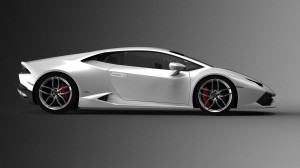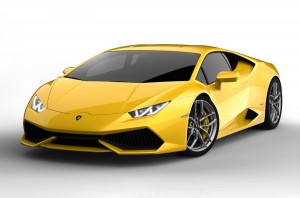
Lamborghini’s latest all wheel drive, 600 bhp V10 car of power and might has been revealed – presenting the Lamborghini Huracan.
The Huracán replaces the Gallardo in Lamborghini’s line-up and is due to reach the UK in the autumn, after a public debut at the Geneva show in March.
The model had been widely tipped to be called Cabrera, but Lamborghini has chosen Huracán — or Huracán LP610-4, to give it its full title — for the name. It continues Lamborghini’s convention of naming its cars after famous fighting bulls, Huracán being a legendary animal that fought in Alicante, Spain, in 1879.
The Huracán follows the same basic formula as the Gallardo, itself the best-selling model in Lamborghini’s history with 14,022 units produced in its 10 years on sale.
The Huracán renews Lamborghini’s assault on the fiercely fought supercar segment with more power and performance, new underpinnings, a high-quality new interior, a new look inspired by the larger Aventador and what the firm describes as an “innovative technology package”.

Much of this specification appears to address the main criticisms of the outgoing Gallardo, which was feeling its age next to more powerful, more modern and higher-quality rivals such as the Ferrari 458 and McLaren 12C.
The mid-engined Huracán’s chassis mixes aluminium and carbonfibre components which, Lamborghini claims, provide “race-car precision with outstanding stiffness”. The chassis is to be shared with the second-generation Audi R8, due in 2015.
Lamborghini had discussed the use of a carbonfibre monocoque for the Huracán, but parent firm Audi deemed the structure too costly to secure the necessary economies of scale for the R8.
The Huracán’s chassis is understood to be clothed in a mixture of aluminium and carbonfibre-reinforced plastic bodywork panels.
Lamborghini has not yet released official dimensions for the Huracán, but it appears to be only marginally bigger than its 4345mm long, 1900mm wide and 1165mm high predecessor, although a slight increase over the Gallardo’s 2560mm wheelbase should improve cabin space.
Despite an increase in the use of lightweight materials in its construction, the dry weight of the Huracán has actually increased slightly over that of the Gallardo, from 1410kg to 1422 kg. This is most likely down to the amount of interior and dynamic technology that has been added to give the Huracán what Lamborghini claims is a combination of “absolute performance with easy-to-drive road behaviour” and a “luxurious and sports-orientated finish”.
At the heart of the Huracán is a normally aspirated 5.2-litre V10 engine, heavily updated from its application in the Gallardo to the extent that Lamborghini calls it a new engine, with new direct and indirect injection systems.
It makes 602 bhp at 8250 rpm and 413 lb ft at 6500 rpm, up from the 552 bhp at 8000 rpm and 398 lb ft at 6500 rpm produced by the Gallardo LP560-4.
Top speed has not been quoted, but Lamborghini says it is “over 202mph” — the claimed top speed of the Gallardo LP560-4. The Huracán can crack 0-62 mph in 3.2 sec and 0-124 mph in 9.9 sec, bettering the 0-62 mph time of the Gallardo LP560-4 by half a second.
Economy is improved over the automatic version of the Gallardo LP560-4, from 19.2 mpg to 22.6 mpg, while CO2 emissions are down from 351 g/km to 290 g/km. (I know, it was your first question)
The standard gearbox is no longer a six-speed manual but a seven-speed dual-clutch automatic transmission, christened Lamborghini Doppia Frizione (LDF) and derived from the dual-clutch auto recently added to the Audi R8. Lamborghini has yet to officially confirm the death of the manual gearbox from its range, but it would appear likely, given its absence from the Huracán’s launch line-up.
The gearbox sends drive to the road through an electronically controlled all-wheel drive system. A switch on the steering wheel allows the driver to configure one
of three dynamic modes — Strada, Sport and Corsa — to deliver a drive ranging from “traction orientated” to “extreme performance”.
The system adjusts the engine and gearbox maps and the four-wheel drive system as part of an “extensive modification in the road behaviour of the Huracán”, according to Lamborghini.
Carbon-ceramic brakes feature on the standard specification, while a variable steering system, called Lamborghini Dynamic Steering, and a magnetorheological adjustable damping set-up can be found on the options list.
The styling is derived from the larger Aventador, including its profile, sharp edges, LED light designs and an engine cover with hexagonal detailing.
The high-quality interior of the Huracán is a big step forward from the Gallardo. It features Nappa leather and Alcantara trim and upholstery, a new 12.3in TFT instrument display, increased multimedia options and a more luxurious feel. A full suite of customisable options will be offered.
The Huracán will enter production on a newly equipped production line at Lamborghini’s Sant’Agata HQ in the spring. UK prices have yet to be revealed, but an increase over the £158,976+ Gallardo LP560-4 is expected.
As with the Gallardo, expect a whole host of extra variants of the Huracán to follow, including an open-top Spyder, a higher-performance Superleggera and entry-level rear-wheel-drive versions.
Official Lamborghini Huracan Site